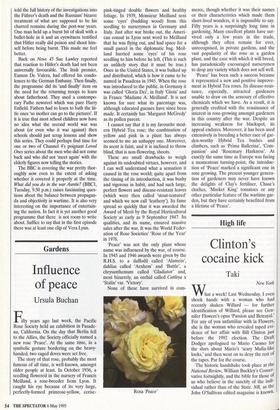Gardens
Influence of peace
Ursula Buchan
Ffty years ago last week, the Pacific Rose Society held an exhibition in Pasade- na, California. On the day that Berlin fell to the Allies, the Society officially named a new rose 'Peace'. At the same time, in a symbolic gesture bordering on the heavy- handed, two caged doves were set free.
The story of that rose, probably the most famous of all time, is well-known, amongst older people at least. In October 1936, a seedling flowered in the nursery of Francis Meilland, a rose-breeder from Lyon. It caught his eye because of its very large, perfectly-formed primrose-yellow, cerise- pink-tinged double flowers and healthy foliage. In 1939, Monsieur Meilland sent some 'eyes' (budding wood) from this seedling to nurserymen in Germany and Italy. Just after war broke out, the Ameri- can consul in Lyon sent word to Meilland that he was flying out, and had space for a small parcel in the diplomatic bag. Meil- land hurried some 'eyes' of his rose seedling to him before he left. (This is such an unlikely story that it must be true.) Once in the United States, it was bulked up and distributed, which is how it came to be named in Pasadena in 1945. When the rose was introduced to the public, in Germany it was called 'Gloria Dei', in Italy 'Gioia' and in France 'Madame A. Meilland'. It is not known for sure what its parentage was, although educated guesses have since been made. It certainly has 'Margaret McGredy' as its pollen parent.
I cannot say that it is my favourite mod- ern Hybrid Tea rose; the combination of yellow and pink in a plant has always seemed to me an unhappy one. Moreover, its scent is faint, and it is inclined to throw blind, that is non-flowering, shoots.
These are small drawbacks to weigh against its undoubted virtues, however, and I can well understand what a sensation it caused in the rose world; quite apart from the timing of its introduction, it was bushy and vigorous in habit, and had such large, perfect flowers and disease-resistant leaves (which were then called 'stout-textured' and which we now call 'leathery'). Its fame spread so quickly that it was awarded the Award of Merit by the Royal Horticultural Society as early as 9 September 1947. Its qualities, and its name, ensured massive sales after the war. It was the World Feder- ation of Rose Societies' Rose of the Year' in 1976.
'Peace' was not the only plant whose name was influenced by the war, of course. In 1945 and 1946 awards were given by the R.H.S. to a daffodil called 'Alamein', dahlias called 'Arnhem' and 'Battle', a chrysanthemum called 'Gladiator' and, most bizarrely, an orchid called Cattleya x 'Stalin' var. 'Victory'.
None of these have survived in com- Rosa 'Peace' merce, though whether it was their names or their characteristics which made them short-lived wonders, it is impossible to say. Fifty years is a surprisingly long time in gardening. Many excellent plants have sur- vived only a few years in the trade, although they often remain for ever, unrecognised, in private gardens, and the vast popularity of the rose as a garden plant, and the ease with which it will breed, has paradoxically encouraged nurserymen to drop any variety which does not sell well.
`Peace' has been such a success because it represented a new and positive improve- ment in Hybrid Tea roses. Its disease-resis- tance, especially, attracted gardeners unable to draw on the armoury of effective chemicals which we have. As a result, it is generally credited with the renaissance of interest in rose-growing amongst gardeners in this country after the war. Despite an increasing weakness for blackspot, its appeal endures. Moreover, it has been used extensively in breeding a better race of gar- den-worthy Hybrid Tea bushes and climbers, such as 'Prima Ballerina', 'Com- passion' and 'Rosemary Harkness'. At exactly the same time as Europe was facing a momentous turning-point, the introduc- tion of 'Peace' marked a significant one in rose growing. The present younger genera- tion of gardeners may never have known the delights of Clay's fertiliser, Chase's cloches, 'Market King' tomatoes or any other particular feature of the wartime gar- den, but they have certainly benefited from a lifetime of 'Peace'.


































































 Previous page
Previous page